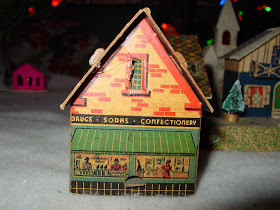I went to an estate sale in Affton a while back that boasted a large vintage train collection. I figured the trains would be priced out of my budget, but I figured it was worth a look. I met a friend there who came with the goal of buying a turntable. We were both met by lots of train enthusiasts, further dimming my hope of getting any trains. We weren't too far back in line, so we made it in the house with the first wave. We were told the trains were in the basement and the mass of people moved in that direction. The group, mostly older men, swarmed the trains like piranha devouring a fallen cow. The group was complely ignoring what had caught my eye -- cardboard houses used as decoration for the train set.
As far back as I can remember (and I'm sure a long time before that), my grandparents displayed little pasteboard houses under their Christmas tree. Over the years I've collected a few of them myself. These houses are commonly known as "glitter houses" or my favorite term "Putz" houses. In this case, "putz" isn't meant to imply a stupid person, but rather the German-American vernacular for "puttering around". The assignment of this term to these houses comes from playing with and rearranging or "putzing around" with the houses under your Christmas tree or with your Nativity display. The earliest examples dating from the 1910's were German-made while Japan entered the market some time in the 1920's or 30's. A good example of a typical putz house is this church I found at the same sale:
But the other houses I found at the sale were different. They were plainer and the only metal in them were the staples holding the corners together. Even the trees were made of cardboard as opposed to the green pipe cleaners used in the earlier putz houses. My guess is these may date from WWII when we were at war with both traditional suppliers of these houses and metal was in shortage. They were reasonably priced at $2 to $3 each.
I believe the dog, wildly out of scale with the house, is a later addition, but I like him. The house is marked 25¢ in pencil on the bottom.
Another house. The trees on the left were additions my wife made for display purposes. Seen in the background is another traditional putz house.
Again, the trees were added to this house (not permanently, just set on the cardboard lawn).
This next one isn't of the same style, but the lithography is pretty nice. I believe this drugstore may have been made for a train set during war time. Lionel famously produced an entire assemble it yourself cardboard train during the war years. This may have been an accessory for that set.
And finally, this well was an earlier find, but a common decoration seen with putz houses. My grandparents had a similar well (my mother still has it). The crank works and pulls up a little bucket out of the well.










No comments:
Post a Comment